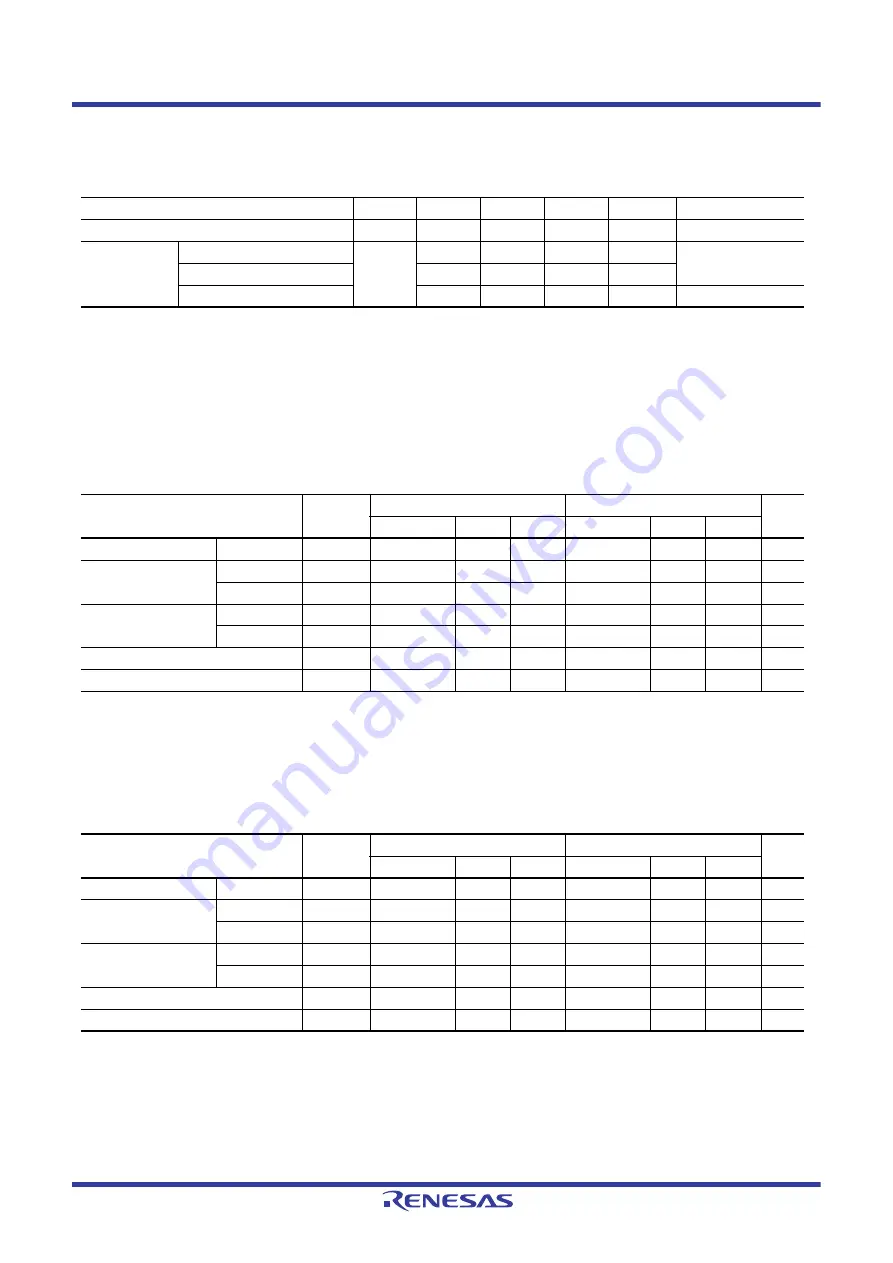
R01UH0823EJ0100 Rev.1.00
Page 1812 of 1823
Jul 31, 2019
RX23W Group
51. Electrical Characteristics
51.14 E2 DataFlash Characteristics (Flash Memory for Data Storage)
Note 1. The reprogram/erase cycle is the number of erasing for each block. When the reprogram/erase cycle is n times (n = 100000),
erasing can be performed n times for each block. For instance, when 1-byte programming is performed 1000 times for different
addresses in a 1-Kbyte block and then the entire block is erased, the reprogram/erase cycle is counted as one. However,
programming the same address for several times as one erasing is not enabled (overwriting is prohibited).
Note 2. Characteristic when the flash memory programmer is used and the self-programming library is provided from Renesas
Electronics.
Note 3. These results are obtained from reliability testing.
Note:
The time until each operation of the flash memory is started after instructions are executed by software is not included.
Note:
The lower-limit frequency of FCLK is 1 MHz during programming or erasing of the flash memory. When using FCLK at below
4 MHz, the frequency can be set to 1 MHz, 2 MHz, or 3 MHz. A non-integer frequency such as 1.5 MHz cannot be set.
Note:
The frequency accuracy of FCLK must be within ±3.5%.
Note:
The time until each operation of the flash memory is started after instructions are executed by software is not included.
Note:
The lower-limit frequency of FCLK is 1 MHz during programming or erasing of the flash memory. When using FCLK at below
4 MHz, the frequency can be set to 1 MHz, 2 MHz, or 3 MHz. A non-integer frequency such as 1.5 MHz cannot be set.
Note:
The frequency accuracy of FCLK must be within ±3.5%.
Table 51.58
E2 DataFlash Characteristics (1)
Item
Symbol
Min.
Typ.
Max.
Unit
Test Conditions
Reprogramming/erasure cycle*
N
DPEC
100000
1000000
—
Times
Data hold time
After 10000 times of N
DPEC
t
DDRP
—
—
Year
T
a
= +85°C
After 100000 times of N
DPEC
—
—
Year
After 1000000 times of N
DPEC
—
—
Year
T
a
= +25°C
Table 51.59
E2 DataFlash Characteristics (2): high-speed operating mode
Conditions: 2.7 V ≤ VCC = VCC_USB = AVCC0 = VCC_RF = AVCC_RF ≤ 3.6 V, VSS = AVSS0 = VSS_USB = VSS_RF = 0 V
Temperature range for the programming/erasure operation: T
a
= –40 to +85°C
Item
Symbol
FCLK = 1 MHz
FCLK = 32 MHz
Unit
Min.
Typ.
Max.
Min.
Typ.
Max.
Programming time
1 byte
t
DP1
—
95.0
797
—
40.8
376
μs
Erasure time
1 Kbyte
t
DE1K
—
19.5
498
—
6.2
230
ms
8 Kbyte
t
DE8K
—
119.8
2556
—
12.9
368
ms
Blank check time
1 byte
t
DBC1
—
—
55.00
—
—
16.1
μs
1 Kbyte
t
DBC1K
—
—
0.72
—
—
0.50
ms
Erase operation forced stop time
t
DSED
—
—
16.0
—
—
10.7
μs
DataFlash STOP recovery time
t
DSTOP
5.0
—
—
5.0
—
—
μs
Table 51.60
E2 DataFlash Characteristics (3): middle-speed operating mode
Conditions: 1.8 V ≤ VCC0 = VCC_USB = AVCC0 = VCC_RF = AVCC_RF ≤ 3.6 V, VSS = AVSS0 = VSS_USB = VSS_RF = 0 V
Temperature range for the programming/erasure operation: T
a
= –40 to +85°C
Item
Symbol
FCLK = 1 MHz
FCLK = 8 MHz
Unit
Min.
Typ.
Max.
Min.
Typ.
Max.
Programming time
1 byte
t
DP1
—
135
1197
—
86.5
823
μs
Erasure time
1 Kbyte
t
DE1K
—
19.6
501
—
8.0
265
ms
8 Kbyte
t
DE8K
—
120
2558
—
27.7
669
ms
Blank check time
1 byte
t
DBC1
—
—
85.0
—
—
50.9
μs
1 Kbyte
t
DBC1K
—
—
0.72
—
—
1.45
ms
Erase operation forced stop time
t
DSED
—
—
28.0
—
—
21.3
μs
DataFlash STOP recovery time
t
DSTOP
0.72
—
—
0.72
—
—
μs











































